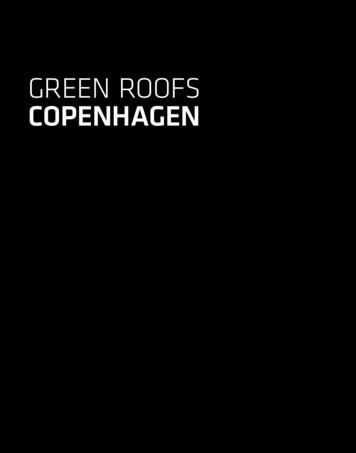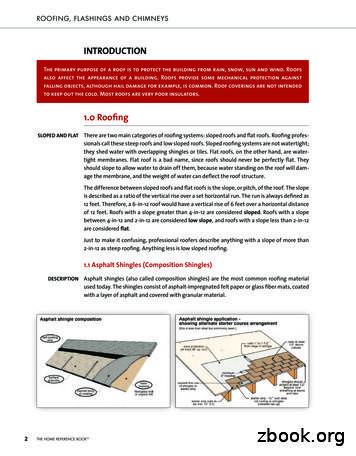Green Roofs: Stormwater Management And Urban Heat
Green Roofs: StormwaterManagement and Urban HeatIsland MitigationPresenter:Jason T. BernerLandscape ArchitectEPA Office of Water, Office of Science andTechnology
Jason Berner National StormwaterTeam member Environmental Impacts& Benefits Assessments Water Quality Modeling Urban Planning andPolicy Analysis
Outline1) Urban Stormwater Water QualityImpacts2)Overview of Green Roofs3) Stormwater Related Benefits ofGreen Roofs4) Examples Applications of GreenRoofs for Stormwater Mitigation5) Tools and Resources for GreenRoofs
Water Quantity Impacts:Changes in Land-Water Linkages
Green Roof Overview Enhances or restores naturalhydrologic cycle (evapotranspiration,retention, minimizes runoff) Vegetation and storage media used forstormwater retention Small storm events (less than .25 to .5inches) in Washington, DC metro area Reduces outside building temperaturesSources: American Society of Landscape Architects (ASLA) (2010) & D. Sample (2010)
Types of Green Roofs Extensive: light vegetation, sedums andgrasses Intensive: medium size vegetation,including shrubs and small woody plantsHybrid green roofIntensive green roofSource: ASLA (2010): http://www.asla.org/ContentDetail.aspx?id 25420
Applications of Green Roofs New DevelopmentRedevelopmentRetrofitsCommercial, Residential, Industrial,and Institutional Building TypesNew Development, Commercial Building, Washington, DC
Benefits of Green Roofs Increases on site retention of stormwater, decreasestotal volume and flow to municipal stormwatersystems Overall reduction in nutrient loadings (Nitrogen &Phosphorus) Enhancement of local site biodiversity Increases stakeholder awareness of local sitestormwater management
Benefits of Green Roofs Increase aesthetic appeal and property valueof property Minimal maintenance costs Less replacements than conventional roofs Possible tax incentives, stormwater utilityfees
Examples of Green Roofs American Society of LandscapeArchitects (ASLA) Green Roof,Washington, DC (Commercial BuildingRetrofit) Monitored stormwater runoff reduction andtemperature reductions Retention of 76.7 % of 11.83 inches rainduring 1st data collection period (Summer –Fall)Source: ASLA (2010): http://www.asla.org/ContentDetail.aspx?id 25362 & http://www.asla.org/ContentDetail.aspx?id 25420
Examples of Green Roofs City Hall, Chicago, IL (institutionalretrofit) Planted in 2000, with over 150 speciesof plants (extensive and intensive) Green Roof able to retain 75% of 1 inchrain eventSources: City of Chicago (2010):Wild New Jersey doe/supp info/chicago s city hallrooftopgarden.html dge-office-on-morristown.aspx
Examples of Green Roofs DC Green Build Out Model (Casey Trees& LimnoTech) Scenarios of how Green Roofs and Treescould be used to mitigate stormwaterdischarges throughout Washington, DC Stormwater Runoff volume reductions upto 10% city-wideSource: Casey Trees (2008): ment/gbo/index.php
Tools & Resources forGreen Roofs Websites: Green Roofs for Healthy Cities (green roofindustry association website): http://www.greenroofs.org/ EPA Green Infrastructure Technologiesand Approaches hnology.cfm EPA Stormwater Menu of ps/index.cfm
Tools & Resources for GreenRoofs Design Tools EPA Models: SWMM (stormwater management model) SUSTAIN (System for Urban StormwaterTreatment and Analysis Integration Model): GISbased with SWMM Stormwater Calculators: Green Values National Stormwater ManagementCalculator (Center for NeighborhoodTechnology) Virginia Runoff Reduction Method (BMP designspreadsheet, VA Dept. Conservation &Recreation)
Thank You, Questions?Contact Information:Happy Free Laborers!!Jason T. BernerLandscape ArchitectEPA Office of Water,Office of Science and Technology,Engineering and Analysis DivisionEmail: Berner.Jason@epa.govPhone: 202-564-9868Website: fmSource: Clean Air Through Green Roofs 9/08/green-roofs-do-require-maintenance.html
Presentation that describes green roofs and benefits in reducing stormwater. Provides green roof case studies and an overview of tools and resources for green roofs. Keywords: Green Roofs, Stormwater Management, Urban
Green Stormwater Infrastructure Maintenance Manual 7 1.1 Introduc on The City of Philadelphia relies in part on Green Stormwater Infrastructure (GSI) systems—comprised of one or more decentralized stormwater management prac ces (SMPs) such as rain gardens, stormwater tree trenches, and green roofs—to reduce stormwater volume and pollutants
Green Stormwater Infrastructure Maintenance Manual 7 1.1 Introduc on The City of Philadelphia relies in part on Green Stormwater Infrastructure (GSI) systems—comprised of one or more decentralized stormwater management prac ces (SMPs) such as rain gardens, stormwater tree trenches, and green roofs—to reduce stormwater volume and pollutants
the Municipalities buildings. Green roofs are also a part of the city’s Strategy for Biodiversity. Since 2010 green roofs are mandated in most new local plans. A calculation based on approved new local plans mandating green roofs gives a total of 200.000 m2 of green roofs to be installed. Today The
NPDES: Stormwater Best Management Practice— — Stormwater Wetland Stormwater Retrofit A stormwater retrofit is a stormwater control (usually structural) that a community puts into place after development to improve water quality, protect downstream channels, reduce flooding or meet other specific objectives.
Green Roof Projects Green roofs are vegetated systems built on roof tops, designed to capture and manage stormwater runoff before it enters the storm sewer system. All green roofs should contain a root barrier, drainage layer, filter layer, growing media, and vegetation. Funding for green roof grants is determined based on green roof area
Pennsylvania Stormwater Best Management Practices Manual December 2006 Stormwater Best Management Practices Manual Cover and Table of Contents Chapter 1 - Introduction and Purpose Chapter 2 - Making The Case For Stormwater Management Chapter 3 - Stormwater Management Principles and Recommended Guidelines
ROOFING LASHING N HIMNEYS INTRODUCTION 1.0 Roofing SLOPED AND FLAT There are two main categories of roofing systems: sloped roofs and flat roofs. Roofing profes-sionals call these steep roofs and low sloped roofs. Sloped roofing systems are not watertight; they shed water with overlapping shingles or tiles. Flat roofs, on the other hand, are water-
ASTM – Revision of ASTM B633 - Zinc Electroplating Standard . The IFI 2018 Annual report will detail that: IFI remains healthy and continues to build reserves, which remain over 2 million, which is sufficient for nearly two years of operations. Workforce development continues to be a major objective for the industry. With orders and production in the final months of 2018 .























